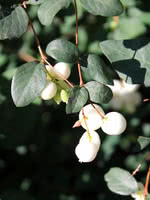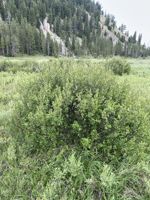Mon-Fri 9am - 5pm Mountain time
Western Snowberry vs Dwarf-Bog Birch
Symphoricarpos occidentalis
Betula glandulosa
NOT AVAILABLE THIS SEASON - MIGHT RETURN
CUSTOM GROW
Like the Common Snowberry, the Western Snowberry is a small shrub with pink flowers useful for feeding livestock and preventing erosion. Unlike the common species, however, the Western Snowberry is much more suited to wet conditions, capable of persevering through poor soil drainage and occasional flooding.
After the Snowberry's flowers have bloomed, it produces berries which often last on the plant through winter. These berries are toxic to humans, but livestock and local wildlife love them! Those hoping to attract wildlife to their property can plant Snowberry and expect to see animals foraging on it much later in the year than other plants.
Dwarf-Bog Birch is a native, cold-hardy shrub that can be found across most of Canada. Its preference for moist soils and the extensive root system make it well-suited for riparian zone plantings, soil stabilization, and erosion control projects.
It features small, round, leathery leaves with scalloped edges and produces small, cone-like catkins. A distinguishing characteristic of the Dwarf-Bog Birch is the presence of large resin glands on the branches and the undersides of the leaves. These resin glands are the reason for its scientific name, Betula glandulosa.
Note: We use Dwarf-Bog Birch for Betula glandulosa. This species is also known by many other common names, including Bog Birch, Dwarf Birch, Glandular Birch, and others. Please confirm the scientific name to ensure you are ordering the correct plant.
Western Snowberry Quick Facts
Dwarf-Bog Birch Quick Facts
Toxicity: berries are toxic to humans

